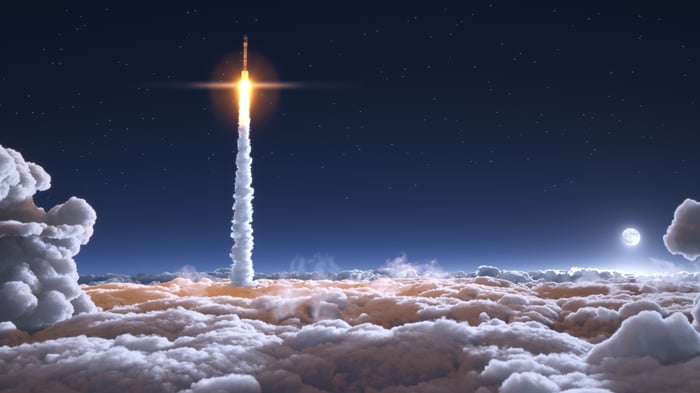KEY POINTS
- On Nov. 18, SpaceX blew up another Starship spaceship and its Super Heavy booster -- but that's just the start of the story.
- SpaceX got Starship to fly twice as long as last time in Saturday's test flight.
- At this point, regulatory delays may be the biggest obstacle to SpaceX doubling Starship's flight time all the way to 100% success.
Starship is getting better and better with each test flight -- and other space companies should be nervous.
Oops. It looks like SpaceX needs to build another Starship.
On Saturday, SpaceX conducted its second-ever flight test of its Starship prototype interplanetary spaceship atop a Super Heavy booster rocket. And as multiple news outlets reported, it ended in disaster:
"Starship test launch ends in explosions" (CBS).
"Starship launch failed minutes after reaching space" (Reuters).
"Starship achieves liftoff and separation, but 'mishap' results in loss of rocket" (NBC).

IMAGE SOURCE: GETTY IMAGES.
Starship blew up. So did Super Heavy.
After launching from its pad near Boca Chica, Texas, at 8:02 a.m. ET on Saturday, Nov.18, SpaceX's booster exploded midflight about three and a half minutes after takeoff. Less than five minutes later, the Starship experienced its own "rapid unscheduled disassembly," apparently in response to an onboard self-destruct command.
But that doesn't mean the mission was a failure. Far from it.
The rest of the story
Yes, there were some big, Technicolor explosions, delivered in full Dolby surround sound. But SpaceX's Starship test flight last weekend also scored multiple successes:
New launch pad technology muffled sound vibrations, and minimized damage to the pad. This greatly improved over April's test, when Super Heavy more or less destroyed its own pad in the process of launching from it.
All 33 Raptor engines on the Super Heavy Booster lit and stayed lit throughout the first stage's flight. This improved over April's test flight performance, when three engines flamed out.
SpaceX proved the concept of "hot-stage separation," in which Starship's six engines lit while Super Heavy was still "on." Starship then powered away from Super Heavy while the latter turned off 30 of its 33 engines, and executed its patented flip-and-boostback maneuver to position itself for relanding back on Earth.
Starship itself then rocketed past the Karman line to space, getting to about 90 miles above the Earth before self-destructing.
And with test flight 2 in the books, SpaceX is already getting ready for test flight No. 3. As CEO Elon Musk quickly confirmed, SpaceX will be ready to improve on last week's performance in less than one month, FAA permitting:
Countdown to 100% success
Of course, that's the real rub. The fact that Starship and Super Heavy weren't 100% successful last week means the Federal Aviation Administration will want to do another "mishap" investigation before allowing SpaceX to try again. And it took the FAA seven months after test flight 1 to OK test flight 2. If it has to wait seven more months for test flight No. 3 -- and for each test flight thereafter -- then things could start to get tricky for SpaceX as it races to get Starship ready to perform a moon landing for NASA under the latter's Project Artemis.
Consider: Test flight 1 aimed to fly for 90 minutes before both halves of the Starship-Super Heavy combo returned to Earth -- but it actually flew fewer than four minutes. Test flight 2 doubled that flight time to eight minutes before rapid unscheduled disassembly.
Now, mathematically speaking, if SpaceX keeps doubling Starship's lifespan with each flight, but the FAA interposes seven-month-long waits between flights, then it might take SpaceX four more test flights to reach 100% success for Starship and Superheavy 28 months from now. This implies a 100% successful Starship system might not arrive before early 2026 -- too late for SpaceX to facilitate NASA's Artemis 3 mission to land astronauts on the moon planned for December 2025.
The timeline gets even more cramped when you recall that, even after Starship is proven safe to fly cargo, SpaceX will want to test-fly Starship multiple times before putting astronauts on the spaceship, to ensure it's safe for humans.
Good news for SpaceX -- and bad news for everyone else
So there's risk to NASA's Project Artemis timeline here. There's also some risk to SpaceX, which may have to wait a bit longer to win additional contracts for additional moon landings, if Artemis is delayed while waiting for Starship to achieve human-rating certification. But the good news for SpaceX -- and the bad news for everyone else who builds rockets -- is that SpaceX is getting closer and closer to success.
Assuming Starship continues to make progress, we're getting closer to the day when SpaceX will possess: (1) the world's largest, most powerful rocket that (2) is fully reusable and (3) therefore doesn't need to be built from scratch for each launch, enabling SpaceX to (4) conduct space launches of both cargo and astronauts for as little as $2 million to $10 million per launch.
Countdown to 100% success
Of course, that's the real rub. The fact that Starship and Super Heavy weren't 100% successful last week means the Federal Aviation Administration will want to do another "mishap" investigation before allowing SpaceX to try again. And it took the FAA seven months after test flight 1 to OK test flight 2. If it has to wait seven more months for test flight No. 3 -- and for each test flight thereafter -- then things could start to get tricky for SpaceX as it races to get Starship ready to perform a moon landing for NASA under the latter's Project Artemis.
Consider: Test flight 1 aimed to fly for 90 minutes before both halves of the Starship-Super Heavy combo returned to Earth -- but it actually flew fewer than four minutes. Test flight 2 doubled that flight time to eight minutes before rapid unscheduled disassembly.
Now, mathematically speaking, if SpaceX keeps doubling Starship's lifespan with each flight, but the FAA interposes seven-month-long waits between flights, then it might take SpaceX four more test flights to reach 100% success for Starship and Superheavy 28 months from now. This implies a 100% successful Starship system might not arrive before early 2026 -- too late for SpaceX to facilitate NASA's Artemis 3 mission to land astronauts on the moon planned for December 2025.
The timeline gets even more cramped when you recall that, even after Starship is proven safe to fly cargo, SpaceX will want to test-fly Starship multiple times before putting astronauts on the spaceship, to ensure it's safe for humans.
Good news for SpaceX -- and bad news for everyone else
So there's risk to NASA's Project Artemis timeline here. There's also some risk to SpaceX, which may have to wait a bit longer to win additional contracts for additional moon landings, if Artemis is delayed while waiting for Starship to achieve human-rating certification. But the good news for SpaceX -- and the bad news for everyone else who builds rockets -- is that SpaceX is getting closer and closer to success.
Assuming Starship continues to make progress, we're getting closer to the day when SpaceX will possess: (1) the world's largest, most powerful rocket that (2) is fully reusable and (3) therefore doesn't need to be built from scratch for each launch, enabling SpaceX to (4) conduct space launches of both cargo and astronauts for as little as $2 million to $10 million per launch.
When everyone else on Earth is still trying to launch rockets for prices measured in the tens and hundreds of millions -- and billions -- of dollars per launch, that's going to make SpaceX the undisputed cheapest rocket launcher on Earth, and potentially make every other rocket and every other rocket company on the planet obsolete.


 DogeHome
DogeHome The Bit Journal
The Bit Journal BlockchainReporter
BlockchainReporter Optimisus
Optimisus CFN
CFN Coincu
Coincu Cryptopolitan_News
Cryptopolitan_News






















